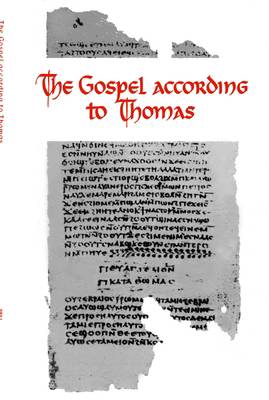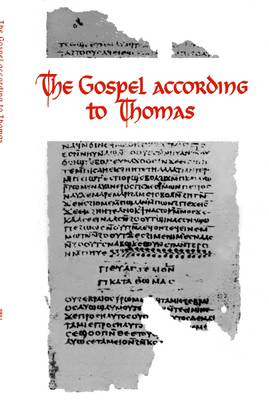
- Afhalen na 1 uur in een winkel met voorraad
- Gratis thuislevering in België vanaf € 30
- Ruim aanbod met 7 miljoen producten
- Afhalen na 1 uur in een winkel met voorraad
- Gratis thuislevering in België vanaf € 30
- Ruim aanbod met 7 miljoen producten
The Gospel According to Thomas
Coptic Text
Guillaumont, Puech, Gilles Quispel, Till, Yassah Abd Al-Masih
Paperback | Engels
€ 17,95
+ 35 punten
Omschrijving
In 1945 thirteen volumes, or fragments of volumes, written on papyrus were found by chance near Nag Hammadi in Upper Egypt. It appears that they had come from the library of a gnostic community and together comprised 49 works, written in Coptic and most of them unknown.
None of the works included in the discovery has been so much discussed and has created so much interest as The Gospel according to Thomas. It is in fact a great collection of Logia, a harvesting of 114 "Sayings of Jesus" together with a prologue which stresses the esoteric character of the sayings and attributes their recording and preservation to the apostle Didymus Jude Thomas.
Many of the sentences are identical with the Logia of the Synoptic Gospels or are closely related to them. Other sayings on the contrary are extracanonical. Among these are certain "agrapha" which were already known or can now be recognized in ancient or medieval literature from patristic, gnostic, Manichaean, or even Catharist sources. Finally, the collection comprises many Logia which are quite new and have never before been seen.
This reprint of the original 1959 edition presents the Coptic text based on a minute examination of the manuscript, together with as faithful a translation as possible.
None of the works included in the discovery has been so much discussed and has created so much interest as The Gospel according to Thomas. It is in fact a great collection of Logia, a harvesting of 114 "Sayings of Jesus" together with a prologue which stresses the esoteric character of the sayings and attributes their recording and preservation to the apostle Didymus Jude Thomas.
Many of the sentences are identical with the Logia of the Synoptic Gospels or are closely related to them. Other sayings on the contrary are extracanonical. Among these are certain "agrapha" which were already known or can now be recognized in ancient or medieval literature from patristic, gnostic, Manichaean, or even Catharist sources. Finally, the collection comprises many Logia which are quite new and have never before been seen.
This reprint of the original 1959 edition presents the Coptic text based on a minute examination of the manuscript, together with as faithful a translation as possible.
Specificaties
Betrokkenen
- Auteur(s):
- Uitgeverij:
Inhoud
- Aantal bladzijden:
- 72
- Taal:
- Engels
Eigenschappen
- Productcode (EAN):
- 9789004048775
- Verschijningsdatum:
- 26/03/2001
- Uitvoering:
- Paperback
- Formaat:
- Trade paperback (VS)
- Afmetingen:
- 157 mm x 239 mm
- Gewicht:
- 158 g

Alleen bij Standaard Boekhandel
+ 35 punten op je klantenkaart van Standaard Boekhandel
Beoordelingen
We publiceren alleen reviews die voldoen aan de voorwaarden voor reviews. Bekijk onze voorwaarden voor reviews.










